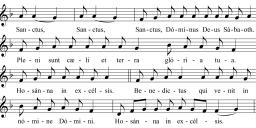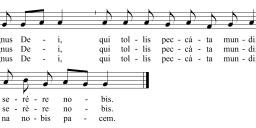Sanctus- Mass xviii
-
Hi all,
My parish fell away from most Latin ordinary in the past decades, and so we are learning the sanctus and agnus dei from mass xviii, and the mortem tuam/amen chants. Struggling to decide on the "rhythm" to teach the choirs/congregation for the Sanctus. The last line- though from my research, seems as though "Hosanna in excelsis Deo" is written as a continuous line- often has a pause between the "Hosanna" and "in excelsis Deo". Better to teach it with the pause since perhaps it is most commonly sung that way? -
I wouldn't agree that it's commonly sung that way. What would lead people to break the line: a lack of well-timed breathing?
-
Others' poor reading and execution isn't a good basis for teaching something incorrectly.
Even the musical phrase is so short that inserting such a pause makes little to no sense.
I'd suggest chanting and teaching it the way it is written. -
I wouldn't put a break between the "Hosanna" and "in excelsis." I have seen in some modern-notation editions a tenuto mark above the last "-na" and have sung it with an ever-so-slight lengthening of that note. In any case, keep the line moving, no breath.Thanked by 1Gaudium
-
So that everyone can literally be on the same page.

 Greg-Sanctus-XVIII.jpg6025 x 2888 - 1M
Greg-Sanctus-XVIII.jpg6025 x 2888 - 1M
 Greg-AgnusDei-XVIII.jpg6012 x 2288 - 900K
Greg-AgnusDei-XVIII.jpg6012 x 2288 - 900K
 MissaXVIII-h-NOH.pdf25KThanked by 1Gaudium
MissaXVIII-h-NOH.pdf25KThanked by 1Gaudium -
When I took over my position, they had been singing Sanctus XVIII with such a lengthening that the -na of the last hosanna was actually performed as if it was a tristropha (in the unrepurcussed 'Old Solesmes' manner), rather than the single punctum it is. I had to get them to unlearn this by playing the tune on the Trumpet. DO NOT put any kind of a pause on that note, it doesn't need it.
My guess is that this lengthening happened from people who were trying to apply the old Solesmes ictus, where the last resort rule is to lengthen a note in order to put an ictus in. So it could be that someone without much training might have wanted a continuous 1-2 in the last line did this:
( )-1 Ho-2 san-1-2 na-1-2 in-1 ex-2 cel-1-2 sis-1-2/1-2 ||
by dotting the punctum on -na, rather than the more reasonable:
( )-1 Ho-2 san-1-2 na-1 in-2 ex-3 cel-1-2 sis-1-2/1-2 || -
Now, then: Say 'Hosanna in excelsis'.
Say it and repeat it two or three times.
Now sing it exactly as you said it.
Only take care to sing 'in' very distinctly from '-na', being aware that they are two separate words.
The same with 'in' and 'ex-'.
(No 'hosanna'nexcelsis'.)
But! no fermata!
Say it again, distinctly, and sing it just as you say it. -
MJO: that works for this chant, and the slogan Sing It Just As You Say It (SIJAYSI) is worth remembering, particularly for Anglican chant, to keep it leavened and to avoid the Thump.
But SIJAYSI doesn’t work for Gregorian much, because of melismas and shifted stresses and weak cadences and other reasons. Even for the Kyrie in this very Mass XVIII, eh? -
Why Andrew! Whatever do you mean???
Don't we all say 'Jubilah-ah-ah-ah-ah-ah-ah....... ah-ah-ah.... te Deo' just like that?????
Seriously, you have hit upon something rather subtle.
In chant, Anglican, Gregorian, or other the SIJAYSI principle is a MUST starting point. The truth is that we don't really sing it exactly that way. We sing it so that it sounds pretty much that way. Yes, it does take some extra care with diction, artfully rendered intervals which don't savage vowel purity, and other niceties of vocalisation to achieve a 'natural' speech-like sound that doesn't sound artificial and contrived, but which is believable as language. So, even if we are singing 'Jubila.........te' we don't loose sight of the fact that we are singing a word, an elaborated portion (elaborated to make a point!) of a word, which we wish to communicate to the hearer.
Perhaps we should modify SIJAYSI to SISTISLS: Sing it so that it sounds like speech -
like an orator's speech, that is. -
Thanks for your replies. You have helped confirm my research and instincts!
Could anyone give a little more history of the various Masses- particularly Deus genitor alme, in terms of when it was written, first used, why it ended up being the one in the Missal, etc, etc? -
The reason the Sanctus as Agnus from the Deus genitor Mass ended up is the Missal is because they were included in the Jubilate Deo booklet published by Paul VI, in turn, they were included in that because they are the simplest in the Kyriale. The Gloria is from Mass XV, the Kyrie from Mass XVI.
The origins of (most of) the Mass ordinaries are hard to trace. The dates of the earliest MSS are given in the Kyriale, but that doesn't really reflect date of composition, as, often, the simplest (and possibly most ancient) were written down latest, since they were easier to remember. Also, there are some differing versions of many ordinary chants from different areas with different traditions: Cf. Kyrie XI, Orbis factor. There are two versions in the Kyriale Romanum, itself, and the Cistercian version, and the Sarum version, etc. Also, in many books different ordinary chants were applied to different days, and the current allocation of Ordinary chants reached its present state only with the publication of the Editio Typica of the Vatican edition in 1908. For example, the Sanctus and Agnus which are part of Mass XVII, for Sundays of Advent and Lent, in the current Graduale Romanum, are given for Sundays per Annum, the current books Mass XI (orbis factor), in the old Medicean Roman Gradual, and other older chant books, and the corresponding chants currently with Mass XI were with the Mass for Advent and Lent.
In the Mediaeval Parisian books Kyrie Cunctipotens (Mass IV) was given for feasts of the BVM -- which is why Machaut uses this chant as the basis for the Kyrie of the Messe de Nostre Dame. &c.
Rest assured, though, that the Kyrie and Gloria of Mass VIII and Credo III are very late chants, and not part of the truly "authentic" corpus of Gregorian Chant, and were mainly included because of their popularity. (The Sanctus and Agnus Dei of this Mass are parodies of authentic chants: the Antiphons "O Quam suavis", and another one, the name of which escapes me at present.)Thanked by 1Gaudium -
For a history of Missa de Angelis try
Caecilia vol 60 no12, Dec 1933.
Welcome to the MusicaSacra Forum!
To participate in the discussions on Catholic church music, sign in or register as a forum member, The forum is a project of the Church Music Association of America.
Categories
- All Discussions21,108
- General Music Discussion8,218
- Job Openings197
- Management of Music Programs850
- Choral Matters533
- Church Documents and Rubrics524
- CMAA Notes302
- Events716
- For Newcomers: Read First26
- Sacred Polyphony546
- Hymnody872
- Gregorian Chant: General2,698
- ↳ Graduale Romanum and Liber Usualis368
- ↳ Graduale Simplex60
- ↳ Semiology63
- Vernacular Plainsong696
- Anglican Use and Anglican Chant68
- Organ, Other Instruments and Repertoire435
- New Composition/Works in Progress1,291
- Recordings231
- Music for Hispanic Ministry159
- Music Education: Children211
- Music Education: General222
- News Items245
- Positions Wanted2
- General Discussion: Catholicism739
- Amusements177
- General Discussion1,033
- Opinions117




